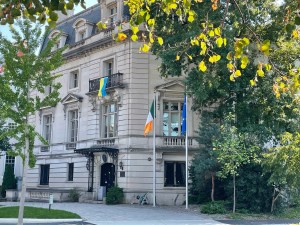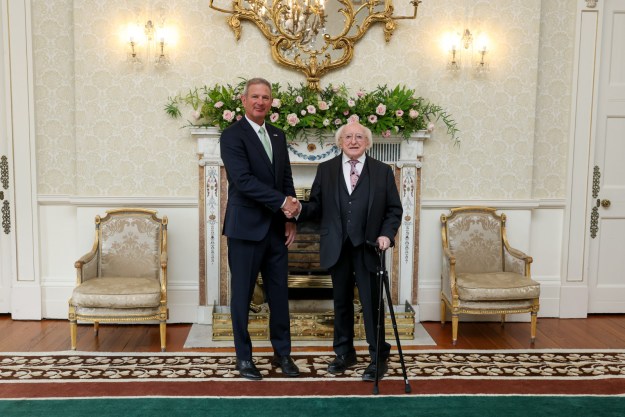Chicago Daily News correspondent William H. Brayden interviewed or mentioned several Irish journalists in his 1925 reporting about the Irish Free State and Northern Ireland. His 16-part series, later consolidated as a small book, also discussed propaganda and the press. I’ve linked to Dictionary of Irish Biography profiles of the journalists and other figures of Irish history mentioned in Brayden’s work. Learn more on Brayden in my series introduction.
Desmond FitzGerald
Brayden described Desmond FitzGerald, the Free State’s minister of external affairs as “the best propagandist ever in Ireland.” In 1919, FitzGerald became director of publicity for Dáil Éireann. In that role, he lobbied international journalists for fair coverage of Ireland and produced the Irish Bulletin to counter anti-Irish narratives published in the London press and British government propaganda.

Desmond FitzGerald
“[The Bulletin’s] offices were raided again and again, and he and his assistants were perpetually ‘on the run,’ ” Brayden recalled. “Yet the little sheet never failed to appear, and when Mr. Fitzgerald was in jail his assistants carried it on.”
The best of those assistants, according to Brayden, were Frank Gallagher and Robert Brennan. They remained ardent republicans after the civil war instead of joining FitzGerald in the Free State government. “I may perhaps be allowed the confession that they are all friends of mine and that I like them all and wish they were not divided,” Brayden revealed in his reporting.
What Brayden declined to disclose to American readers is that he had worked on anti-Sinn Féin propaganda for the British government at Dublin Castle during 1918–1919.
Brayden praised FitzGerald’s influence on the direction of Free State policy. “He has a real sense of the importance to the new state of its world contacts and the ministry could not be in more suitable hands.”
Propaganda and publicity
The Publicity Department was essentially a re-labelling of the Propaganda Department established within the Sinn Féin party for the December 1918 general election campaign. In 1925, the three-year-old Irish Free State government continued to mature through the distinctions and differences between revolutionary propaganda and elected state publicity. Brayden continued:
“It was probably the propaganda aspect of the Free State’s ministry of external affairs that led to the attachment to it of a government publicity department. Whether any state should have a publicity department for supplying information to the press is a debatable point. Many states either openly or otherwise find that publicity is an essential. But from the first the Free State publicity department , though conducted by men of the highest skill in journalistic work, was a target for criticism. It proved extremely useful to newspaper men in dealing with the welter of alarming and contradictory statements about Ireland which in the last few years were published in the newspapers of the world. But it was not easy always to distinguish between publications called for in the interests of the state as a state and publications in the interest of the particular political party which at the time is governing the state.
… even amongst Free Staters a distinction was seen. The government had all the press of Ireland behind it. The republicans had nothing but a small weekly sheet. The big battalions of the press did not need the assistance of state publicity. Nor indeed did they welcome it, for the severest critics of the publicity department were always found in the newspapers that were saying the same thing and, if it be not an impertinence to add, were not always saying it so well.”
Brayden also nodded to the earlier work of journalist Arthur Griffith. The Sinn Féin founder used his writing before the armed struggle of 1919-1921 to emphasize the importance of Ireland’s economic independence. “In one after another of his newspapers–a new one started when the old was suppressed–[Griffith] poured forth articles on Ireland’s economic needs and the natural resources with which they could be met,” Brayden wrote in his 1925 series, three years after Griffith’s death. “One of the first acts of the new state was to establish a ministry of industry and commerce. This is now the busiest of all the Free State government departments.”
Keane in Kilkenny
Braydon called on Edward Thomas Keane, “a veteran among Irish journalists” and editor of The Kilkenny People. Keane helped establish the pro-Parnellite newspaper in 1892, then later became a supporter of Sinn Féin. The paper was suppressed for over two months in 1917, then again in 1919, when Keane was imprisoned. Braydon reported that Keane was unable to claim any compensation for the second episode under the terms of the Anglo-Irish Treaty.
Nevertheless, the visitor described Keane as “a strong supporter” of the treaty. “He thinks it gives the country a real freedom.” Keane “confessed himself an optimist” about the local economy under the three-year-old Free State government.

During his visit to Kilkenny, Braydon also met the woman manager of “an excellently equipped stationery and news store” that sold several Irish American papers. She “complained bitterly that about £20 worth of an issue of one of them had been seized and confiscated by the Free State police,” Brayden reported. He surmised the state’s objection must have been confined to the one issue, since “the current numbers were prominently displayed in the store.”
Unfortunately, Brayden said he could not learn the reason for the seizure, and he did not name the paper. I was unable to locate the incident in the Irish Newspaper Archives.
Downey in Waterford
Thirty-five miles to the south, Brayden “found somewhat less optimism in Waterford” than in Kilkenny. Poverty and unemployment were high after a series of crippling strikes. Here, Braydon interviewed Edmund Downey, owner of the Waterford News since 1906.
The paper had been suppressed for four months in 1918 by the British military, and “still harder hit under the Free State” as an opponent of the treaty. “His premises were burned out, and, according to his testimony, the national army did the burning,” Brayden wrote.
The fire occurred in August 1923. At the time, the Northern Standard described the Waterford News as “markedly republican.” Damages were estimated at £20,000. The News was later awarded £4,750 after a trail in which Downey testified against the state.

During their conversation, Brayden and Downey debated 1925 changes to the Irish poor law system, which had preceded the Great Famine of the mid-nineteenth century. Workhouses and similar institutions were abolished, with relief service transferred to new county-level boards. “According to him the new system is more costly than the old and less efficient,” Brayden reported. The correspondent declared that he personally regarded the changes “as one of the important reforms of the latest Free State legislation.”
Finally, Brayden also made a few references to his earlier reporting for the Chicago Daily News. A story about his visit to Cork noted that he had not been to the city since March 1920, to cover the murder of Lord Mayor Tomás MacCurtain. Brayden also described Patrick J. Hogan, the Free State’s minister of agriculture, as “one of the most effective of the pro-treaty speakers” in his Daily News reporting of the January 1922 Dáil debates on whether to accept the measure.
***
This is the sixth and final installment of my series about Brayden. See earlier posts and all my work on American Reporting of Irish Independence.





















